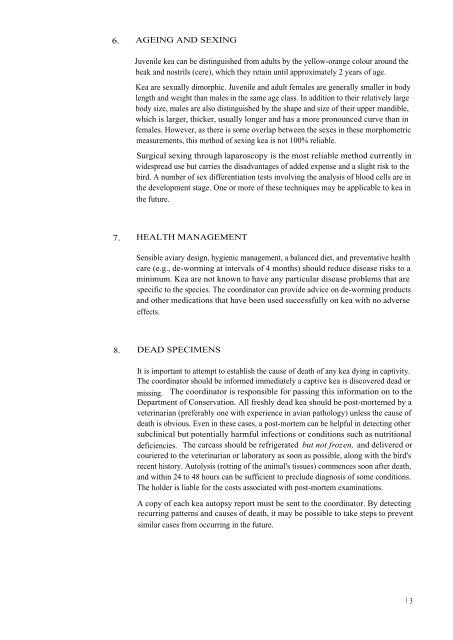Kea (Nestor notabilis) Captive Management Plan and Husbandry ...
Kea (Nestor notabilis) Captive Management Plan and Husbandry ...
Kea (Nestor notabilis) Captive Management Plan and Husbandry ...
Create successful ePaper yourself
Turn your PDF publications into a flip-book with our unique Google optimized e-Paper software.
6. AGEING AND SEXING<br />
Juvenile kea can be distinguished from adults by the yellow-orange colour around the<br />
beak <strong>and</strong> nostrils (cere), which they retain until approximately 2 years of age.<br />
<strong>Kea</strong> are sexually dimorphic. Juvenile <strong>and</strong> adult females are generally smaller in body<br />
length <strong>and</strong> weight than males in the same age class. In addition to their relatively large<br />
body size, males are also distinguished by the shape <strong>and</strong> size of their upper m<strong>and</strong>ible,<br />
which is larger, thicker, usually longer <strong>and</strong> has a more pronounced curve than in<br />
females. However, as there is some overlap between the sexes in these morphometric<br />
measurements, this method of sexing kea is not 100% reliable.<br />
Surgical sexing through laparoscopy is the most reliable method currently in<br />
widespread use but carries the disadvantages of added expense <strong>and</strong> a slight risk to the<br />
bird. A number of sex differentiation tests involving the analysis of blood cells are in<br />
the development stage. One or more of these techniques may be applicable to kea in<br />
the future.<br />
7. HEALTH MANAGEMENT<br />
Sensible aviary design, hygienic management, a balanced diet, <strong>and</strong> preventative health<br />
care (e.g., de-worming at intervals of 4 months) should reduce disease risks to a<br />
minimum. <strong>Kea</strong> are not known to have any particular disease problems that are<br />
specific to the species. The coordinator can provide advice on de-worming products<br />
<strong>and</strong> other medications that have been used successfully on kea with no adverse<br />
effects.<br />
8. DEAD SPECIMENS<br />
It is important to attempt to establish the cause of death of any kea dying in captivity.<br />
The coordinator should be informed immediately a captive kea is discovered dead or<br />
missing. The coordinator is responsible for passing this information on to the<br />
Department of Conservation. All freshly dead kea should be post-mortemed by a<br />
veterinarian (preferably one with experience in avian pathology) unless the cause of<br />
death is obvious. Even in these cases, a post-mortem can be helpful in detecting other<br />
subclinical but potentially harmful infections or conditions such as nutritional<br />
deficiencies. The carcass should be refrigerated but not frozen, <strong>and</strong> delivered or<br />
couriered to the veterinarian or laboratory as soon as possible, along with the bird's<br />
recent history. Autolysis (rotting of the animal's tissues) commences soon after death,<br />
<strong>and</strong> within 24 to 48 hours can be sufficient to preclude diagnosis of some conditions.<br />
The holder is liable for the costs associated with post-mortem examinations.<br />
A copy of each kea autopsy report must be sent to the coordinator. By detecting<br />
recurring patterns <strong>and</strong> causes of death, it may be possible to take steps to prevent<br />
similar cases from occurring in the future.<br />
1 3












